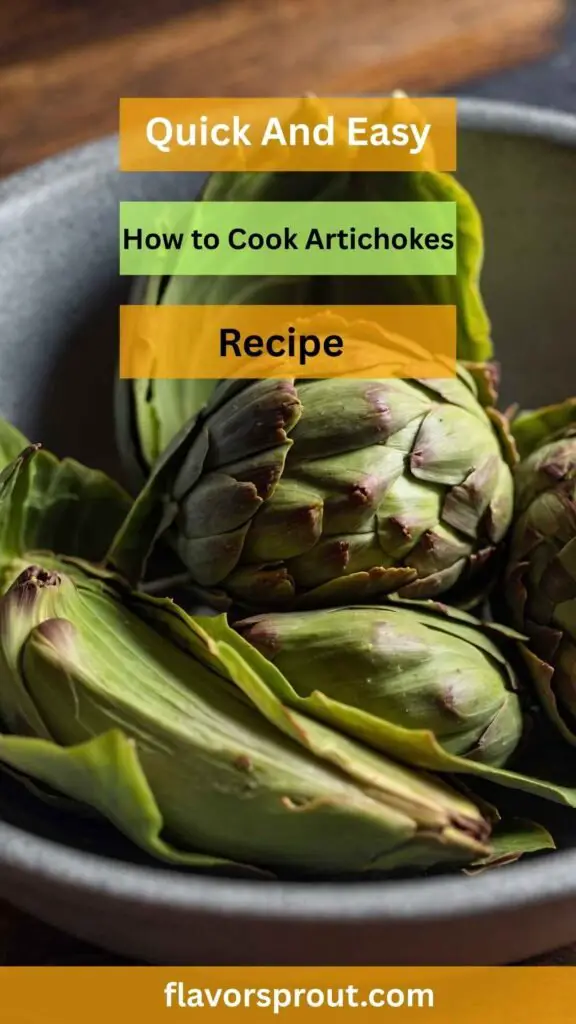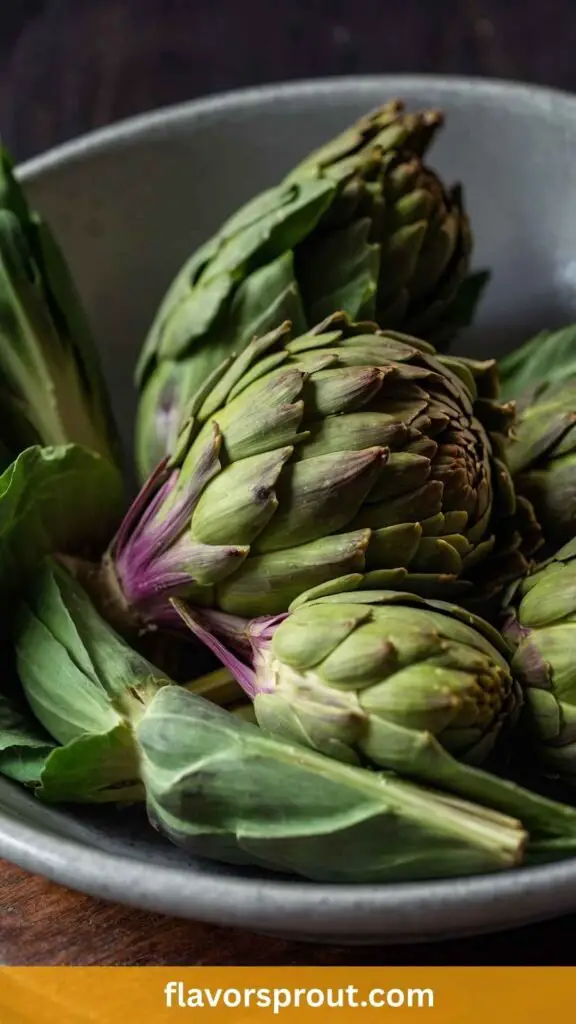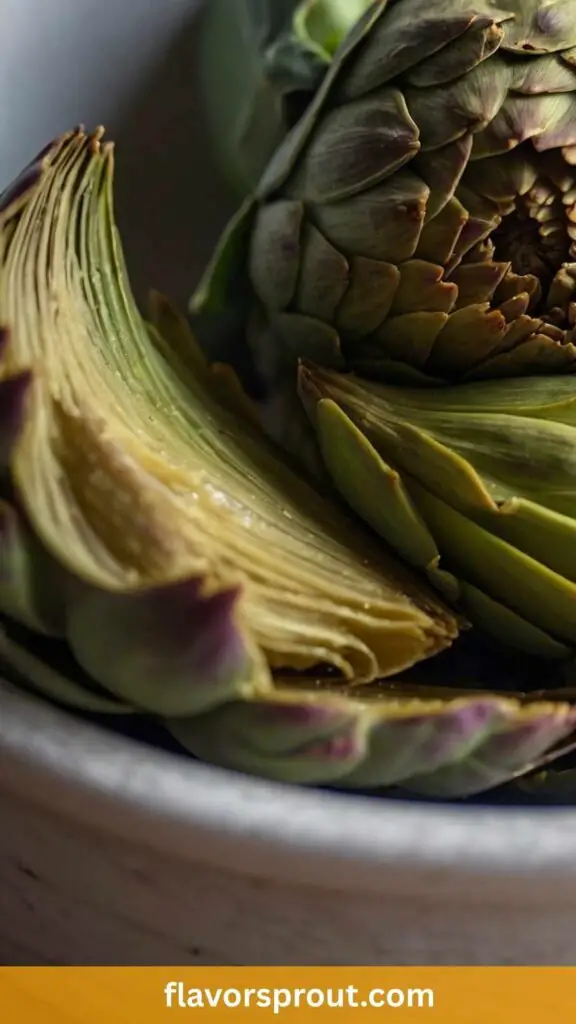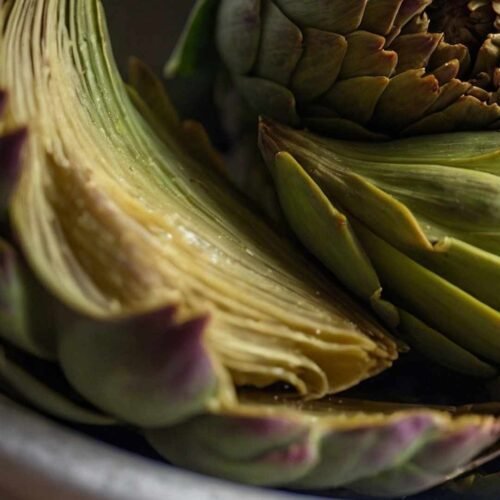Artichokes boast a unique flavor, making them a fantastic centerpiece for various meals. They pair well with a zesty lemon-garlic aioli or a rich balsamic dip. Enjoy them alongside grilled meats, seafood, or toss them into a vibrant salad. Picture this: juicy grilled chicken, light, fresh artichokes, and a drizzle of homemade lemon-dill dressing for a perfect summer meal.
Now, let’s dive into the art of cooking artichokes!

You’ll Also Like These Recipes
- Pairing Suggestions for Cheesy French Onion Soup Recipe
- Buttery Parsley Potatoes
- Creamy Dilled Red Potato Salad Recipe
Cooking artichokes can sound intimidating. In all honesty, I felt the same way when I first laid eyes on these spiky green wonders. But here’s the truth: they are surprisingly simple to prepare, and the reward is immense. They transform an ordinary meal into an extraordinary one, both in taste and presentation. Trust me, after reading this, you’ll be craving artichokes.
What is How to Cook Artichokes?
At their essence, cooking artichokes involves three primary methods: steaming, boiling, or roasting. Each method brings out the natural nutty and slightly sweet flavor of this unique vegetable, primarily comprised of tender, fleshy leaves.
Our journey today will spotlight steaming—arguably the best method to retain flavor and nutrients while keeping the texture delightful.
What is the Flavor Profile of Artichokes?
Artichokes have a distinct, subtly nutty flavor that’s often likened to a blend of asparagus and celery. The hearts are tender, while the outer leaves offer a slight chewiness. Each bite is synonymous with spring, brightened by notes of earthiness and a gentle sweetness. The flavor intensifies when accompanied by lemon, garlic, or herbs, bringing a fresh zing to its natural profile.
What Makes This Recipe Different From Other How to Cook Artichokes?
Many recipes might skim the surface, but here’s where we break it down step-by-step. I’ll share tips from my own kitchen trials. You see, I’ve cooked dozens of artichokes, learning what works best—what to avoid and how to enhance the flavor. This isn’t about just boiling or steaming. It’s about elevating artichokes into a star dish at your dining table.
Ingredients You’ll Need
To make your artichoke experience memorable, gather the following ingredients:
- 1 teaspoon olive oil: Adds richness and carries flavors smoothly.
- 1 bay leaf: A touch of earthy aroma that complements the dish.
- 1-2 cloves garlic, halved: Unpeeled, these infuse subtle garlic notes.
- 2-3 sprigs of fresh thyme or parsley: For a fragrant lift.
- 1 thin slice of lemon: Brings brightness and prevents browning.
- 1 or more large globe artichokes, trimmed: The star of the show!
- Optional: pinch of sea salt: Elevates flavor, especially in steaming.

Step-by-Step Directions
Step 1: Preparing the Artichoke
Start by washing your artichoke under cold running water. By rinsing, you’ll remove any dirt tucked between the layers. Next, with a sharp knife, cut off about an inch from the top of the artichoke. You don’t want any prickly tips that might ruin your culinary masterpiece! Trim the stem to about an inch as well, ensuring the artichoke can stand upright.
Step 2: Trimming the Leaves
To ease your experience, gently pull the outer leaves down. Don’t be shy! You want to remove the tough outer leaves until you reach the tender ones. You’ll notice a color change; the inner leaves are paler and less spiky. This is exactly what you want.
Step 3: Keeping it Fresh
To prevent discoloration, squeeze fresh lemon juice over the trimmed artichoke or drop the slice right into the cooking pot. This simple step brightens flavor and aids in maintaining their lovely hue.
Step 4: Setting Up the Pot
In a large pot, pour about 2 inches of water. Add the olive oil, bay leaf, garlic, thyme, and any seasonings. Place a steamer basket above the water; this is where your artichokes will live and thrive. The garlic and herbs will aromatize the water.
Step 5: Steaming the Artichoke
Bring the pot to a boil. Once boiling, carefully place the artichokes in the steamer basket. Reduce the heat to a gentle simmer. Cover the pot and let them steam for about 30-40 minutes. Life tip: check your artichokes at the 30-minute mark. They are done when you can easily pull a leaf from the base.
Step 6: Serving
Once the artichokes are tender, remove them from the pot with tongs and let them rest on a plate. You can serve these beauties warm or at room temperature. Add melted butter or a drizzle of lemon vinaigrette for an irresistible finishing touch.
Tips On Making Artichokes
- Fresh is Best: Choose artichokes that are firm and vibrant green. Avoid any that look dried out or brown.
- Don’t Rush: Steaming them perfectly can take time. If you think they’re ready, pull one leaf!
- Experiment With Flavors: Don’t hesitate to add spices or aromatic herbs to the steaming water for extra flavor.
- Serve with Dipping Sauces: Try garlic aioli, green goddess dressing, or simple lemon-butter. They enhance the experience significantly!
- Double-Check Cooking Times: Depending on the size of your artichokes, cooking times may vary.
Nutrition Information
Artichokes are a powerhouse of nutrition. A medium-sized artichoke contains about:
- 60 calories
- 3 grams of protein
- 14 grams of carbohydrates
- 0 grams of fat
- 7 grams of fiber
They’re rich in antioxidants, vitamins C, K, and B6, and minerals like magnesium and potassium. That’s healthy with a capital H!
How Can I Store This Artichokes?
If you happen to have leftover steamed artichokes (though I doubt it!), here’s how to store them:
- Refrigerate: Place leftovers in an airtight container. They can last about 2–3 days in the fridge.
- Freezing: If you want to store them long-term, freeze them after steaming. Just make sure to cool completely first; use freezer bags, removing as much air as possible.

Substitute Options for the Ingredients
Sometimes we can’t find exactly what we need in our kitchens. Here are some reliable substitutes:
- Olive Oil: Can be replaced with avocado oil. It has a high smoke point and a light flavor.
- Bay Leaf: If you don’t have bay leaves handy, use dried oregano or thyme for similar earthy notes.
- Garlic: No fresh garlic? Try garlic powder. A teaspoon is generally equivalent to one clove.
- Fresh Herbs: If thyme or parsley isn’t available, consider basil or even cilantro for a different twist on flavor.

How to Cook Artichokes
Equipment
- Pot
Ingredients
- 1 teaspoon olive oil: Adds richness and carries flavors smoothly.
- 1 bay leaf: A touch of earthy aroma that complements the dish.
- 1-2 cloves garlic halved: Unpeeled, these infuse subtle garlic notes.
- 2-3 sprigs of fresh thyme or parsley: For a fragrant lift.
- 1 thin slice of lemon: Brings brightness and prevents browning.
- 1 or more large globe artichokes trimmed: The star of the show!
- Optional: pinch of sea salt: Elevates flavor especially in steaming.
Instructions
Step 1: Preparing the Artichoke
- Start by washing your artichoke under cold running water. By rinsing, you’ll remove any dirt tucked between the layers. Next, with a sharp knife, cut off about an inch from the top of the artichoke. You don’t want any prickly tips that might ruin your culinary masterpiece! Trim the stem to about an inch as well, ensuring the artichoke can stand upright.
Step 2: Trimming the Leaves
- To ease your experience, gently pull the outer leaves down. Don’t be shy! You want to remove the tough outer leaves until you reach the tender ones. You’ll notice a color change; the inner leaves are paler and less spiky. This is exactly what you want.
Step 3: Keeping it Fresh
- To prevent discoloration, squeeze fresh lemon juice over the trimmed artichoke or drop the slice right into the cooking pot. This simple step brightens flavor and aids in maintaining their lovely hue.
Step 4: Setting Up the Pot
- In a large pot, pour about 2 inches of water. Add the olive oil, bay leaf, garlic, thyme, and any seasonings. Place a steamer basket above the water; this is where your artichokes will live and thrive. The garlic and herbs will aromatize the water.
Step 5: Steaming the Artichoke
- Bring the pot to a boil. Once boiling, carefully place the artichokes in the steamer basket. Reduce the heat to a gentle simmer. Cover the pot and let them steam for about 30-40 minutes. Life tip: check your artichokes at the 30-minute mark. They are done when you can easily pull a leaf from the base.
Step 6: Serving
- Once the artichokes are tender, remove them from the pot with tongs and let them rest on a plate. You can serve these beauties warm or at room temperature. Add melted butter or a drizzle of lemon vinaigrette for an irresistible finishing touch.
Notes
- Fresh is Best: Choose artichokes that are firm and vibrant green. Avoid any that look dried out or brown.
- Don’t Rush: Steaming them perfectly can take time. If you think they’re ready, pull one leaf!
- Experiment With Flavors: Don’t hesitate to add spices or aromatic herbs to the steaming water for extra flavor.
- Serve with Dipping Sauces: Try garlic aioli, green goddess dressing, or simple lemon-butter. They enhance the experience significantly!
- Double-Check Cooking Times: Depending on the size of your artichokes, cooking times may vary.
Nutrition
Frequently Asked Questions
1. Can I cook artichokes in the microwave?
Yes! Trim the artichokes, place them in a microwave-safe bowl with a bit of water, covered with a lid. Microwave on high for about 5–8 minutes, checking for doneness.
2. How do I know when my artichokes are done cooking?
They’re ready when you can easily pull one of the leaves from the base. The flesh should be tender, not crunchy.
3. Are artichokes safe to eat raw?
While it’s uncommon to eat them raw because of their fibrous texture, the hearts can be eaten raw after being thinly sliced.
4. What is the best way to eat an artichoke?
Pull off the leaves one by one, dip them into your sauce, and scrape the tender flesh with your teeth. Don’t forget to savor the heart at the center—it’s the most delicious part!
5. Can I cook artichokes ahead of time?
Absolutely! You can steam or boil them a day before your event. Just cool them down, refrigerate, and reheat when you’re ready to serve!
Conclusion
Cooking artichokes may seem daunting at first, but with a little practice, you’ll transform this exotic vegetable into culinary magic. Steaming not only preserves their flavor but also allows for endless pairing possibilities.
Try experimenting with different dips and sides, and you’ll find new ways to savor this delightful veggie. So, what are you waiting for? Gear up your kitchen and let the artichoke adventure begin! Your dining experience will never be the same again.




